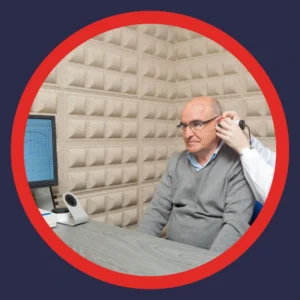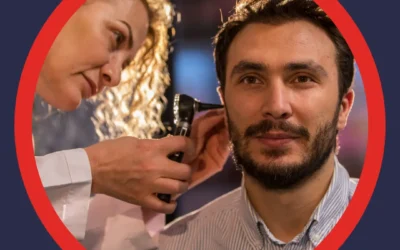Small hearing aids changed the playbook. They hide well and still perform. Many deliver clarity that rivals larger styles. They fit comfortably for long days. They also keep daily routines simple. No one needs to know unless you want them to. With the right match, small hearing aids feel natural, look discreet, and stay useful from breakfast to bedtime.
Here are the big wins people notice most:
- Discreet look in real life. Invisible hearing aids and tiny in-canal styles sit deep. Friends usually do not spot them. Photos stay about you, not your devices.
- Clearer listening with less effort. Smart chips clean up noise and shape speech. Your brain works less to follow a fast talker.
- Comfort with fewer snags. Small shells stay out of the way of glasses. Masks, hats, and headsets cooperate.
- Pocketable power and features. The latest compact models support streaming and app control. You get practical tech without bulk.
These benefits matter whether you are new or upgrading. Style choices shape how each advantage shows up day to day. That brings us to the layouts that keep everything small yet capable.
The Small Styles at a Glance: IIC vs CIC vs Micro RIC
Small hearing aids come in three main flavors. Invisible-in-the-canal sits deepest. Completely-in-canal sits slightly shallower. Micro RIC places a tiny case behind the ear. Each design solves a different comfort, discretion, and feature puzzle.
Small Styles Side by Side
|
Style |
Visibility |
Best For |
Battery/Charging |
Connectivity |
Handling |
Wind/Noise Performance |
|
IIC hearing aids |
Virtually invisible deep in the canal |
Mild to moderate loss |
Tiny disposable size 10 batteries |
Bluetooth and telecoil not typical |
Tricky for dexterity; uses a small removal thread |
Excellent wind protection; fewer directional tools for noise |
|
CIC |
Very discreet within the canal |
Mild to moderately severe loss |
Mostly disposable; a few rechargeable CICs exist |
Limited wireless options compared with RIC |
Easier than IIC, still small parts |
Good wind protection; modest directionality |
|
Micro RIC / microRIE |
Discreet behind ear with a thin wire |
Mild to severe loss |
Commonly rechargeable with all-day power |
Full Bluetooth streaming and app control |
Larger shell helps handling and care |
Strong directionality and AI for noisy places |
You can expect rapid advances across all three styles. For a quick view of what is coming next, see the latest tech trends. Those ideas frame where features fit, which we break down next in simple terms.
Tiny But Mighty: What Features Fit Where
Small hearing aids pack a lot for their size. The exact feature set depends on style and space. Invisible hearing aids focus on stealth. Micro RIC models focus on performance and connectivity. The right pick balances what you want others to see with what you need to hear.
IIC strengths you can bank on
- True invisibility. IIC hearing aids sit past the second bend. They hide completely.
- Natural acoustics. The deep fit uses the pinna for localization and clarity.
- Low wind noise. The canal shields the mic from gusts during walks and rides.
- Custom shells. Each device matches your canal for comfort and retention.
IIC trade-offs to consider
- Battery realities. Most IICs use tiny disposable size 10 batteries.
- Wireless limits. Direct Bluetooth streaming and telecoils rarely fit.
- Noise tools. Single mic designs reduce access to strong directionality.
- Handling. Small parts challenge fingers that prefer larger grips.
microRIE strengths that shine daily
- Rechargeability. Most micro RIC models run all day on lithium power.
- Full connectivity. They support Bluetooth streaming and app control.
- Directional microphones. Dual mics help speech cut through noise.
- Fit range. They suit mild to severe losses with the right receiver.
microRIE trade-offs to weigh
- Slight visibility. A tiny case sits behind the ear with a thin wire.
- Wind exposure. Mics outside the canal can catch more breeze.
- Glasses and gear. Frames and straps may share space behind the ear.
Who typically qualifies for each style
- IIC or CIC fits many mild to moderate losses. Power remains limited.
- microRIE supports mild through severe losses with more headroom.
- Your ear canal matters. Shape and size can rule in or out an IIC shell.
- Your priorities matter too. Decide if invisibility or features lead.
Research continues to shrink parts and boost processing. See recent work in audiology research from USF. These patterns set up our model shortlist, where tiny shells meet standout features.
Model Shortlist: The Smallest Hearing Aids With Standout Features
We chose tiny hearing aids that balance discretion with practical features patients use daily. The list spans truly invisible IIC devices and compact micro RIC designs that carry full connectivity.
Top Tiny Models and Key Advantages
Model |
Style |
Why It Stands Out |
Best For |
|
Phonak Lyric |
Extended-wear IIC |
Worn 24/7 for months; truly invisible deep fit |
Maximum invisibility with zero daily handling |
|
Phonak Virto Paradise/Infinio Titanium |
Custom IIC |
Thin titanium shell enables smaller, deeper custom fits |
Deep fit seekers who want durable shells |
|
Oticon Own IIC |
Custom IIC |
On-board DNN for clear, natural sound in a tiny shell |
Discreet users who value brain-friendly sound |
|
Starkey Genesis AI IIC/CIC |
Custom IIC/CIC |
Fast AI processing with robust clarity features |
Tiny fit with strong speech optimization |
|
Signia Insio IX IIC/CIC |
Custom IIC/CIC |
Latest Signia processing in highly discreet customs |
Small custom shells with modern tuning |
|
ReSound Nexia IIC |
Custom IIC |
Moisture-resistant nano coating for deep-canal durability |
Invisible fit with reliability focus |
|
ReSound Vivia microRIE |
micro RIC |
Ultra-small rechargeable RIC with AI and streaming |
Discretion plus full connectivity |
|
Starkey Genesis AI mRIC |
micro RIC |
Rechargeable, app control, wellness tools |
Small RIC with helpful extras |
|
Oticon Intent miniRITE R |
micro RIC |
Intent sensors guide support in real time |
Small RIC that adapts to your focus |
|
Signia Pure Charge&Go IX |
micro RIC |
Strong directionality and easy handling |
Noisy settings with small RIC design |
|
Signia Silk Charge&Go IX |
Instant-fit CIC |
Ultra-discreet, rechargeable CIC with soft click sleeves |
Tiny, quick fit without impressions |
If you want a sense of 24/7 wear in real life, read living with Lyric. It shows how extended-wear invisibility compares with daily-wear styles. Now let’s zero in on who benefits most from the smallest shells and how to care for them.
Invisible-in-the-Canal Essentials: When IIC Is the Right Choice
Invisible hearing aids shine when invisibility leads your priorities. They suit many first timers and upgraders who want the smallest look possible. A careful fit and routine care keep performance steady and comfort high.
Who typically benefits from IIC
- You value a device no one can see in daily life.
- Your hearing loss ranges from mild to moderate.
- Your ear canals allow deep, stable placement.
- You do not need constant Bluetooth streaming.
Handling tips that make life easier
- Practice insertion with a mirror and steady lighting.
- Use the removal thread gently and pull straight out.
- Keep a small case for spare size 10 batteries.
- Set app or remote adjustments with your audiologist.
Care and maintenance that keep IICs reliable
- Wipe shells daily with a dry cloth. Avoid fluids.
- Swap wax guards before feedback or muffled sound appears.
- Schedule clean-and-check visits every few months.
- Ask for venting tweaks if your voice sounds boomy.
Expectations that match the tiny form factor
- Most IICs use disposable batteries to save space.
- Direct streaming and telecoils are uncommon in this size.
- Directional microphones are limited by single mic designs.
- Comfort improves as your ear adapts over the first weeks.
If you compare brands inside this tiny category, start with this concise overview of ReSound vs Starkey. It shows how two leaders approach sound and features. With those basics in mind, the next big question is performance in noisy places.
Winning the Restaurant Test: micro RIC vs IIC in Noise
Picture a crowded bistro. Voices bounce, plates clink, and music plays. Small hearing aids handle this scene very differently. Your comfort and clarity depend on microphone layout, app tools, and smart accessories.
Why micro RIC models usually win here
- Dual microphones shape directionality. The behind-ear case holds two mics. They focus on speech and soften side noise.
- AI helps separate voices. Modern micro RIC platforms use deep learning for cleaner conversation.
- App control adds a quick boost. You can nudge noise reduction or switch programs in seconds.
- Accessories extend the edge. A remote mic on a table lifts your partner’s voice cleanly.
Where IIC hearing aids still help
- Lower wind noise outdoors. The deep canal placement shields the mic from gusts.
- Natural localization cues. The ear’s shape guides sound for a realistic scene.
- True invisibility for confidence. Some users engage more when they forget the device.
Limits to remember in loud places
- IIC hearing aids use a single small mic. Directional tools stay limited.
- micro RIC devices sit near glasses and masks. Seat choice can reduce bumps.
- Any style works better when you face the talker and reduce background clatter.
For a deeper dive on settings and accessories, see our guide to the best for noisy places. With noise under control, power and fitting become the next step.
Power Users: Small Options for More Severe Hearing Loss
Small hearing aids can still bring strong power. The trick is pairing the shell with the right receiver and fit. With careful tuning, many patients keep a discreet profile without losing needed gain.
How micro RIC models extend power
- Swap receivers for gain. Higher power receivers lift output without changing shells.
- Seal matters. Closed domes or custom earmolds prevent feedback and boost lows.
- Battery headroom helps. Rechargeable cells support stronger processing all day.
- Feedback control counts. Modern algorithms allow more gain before whistling.
When tiny IIC or CIC may not be enough
- Severe to profound losses demand output tiny shells cannot deliver.
- Vent limits in deep-fit devices can restrict bass and comfort.
- Single microphone layouts reduce directional help in loud scenes.
- Handling gets harder as parts shrink and power needs rise.
Smart ways to keep devices small yet strong
- Start with a micro RIC form factor and a stronger receiver.
- Request a custom earmold if feedback appears at target gain.
- Use a remote mic for distance hearing in meetings or worship.
- Keep wax management tight to preserve gain and clarity.
If your audiogram pushes the limits of tiny shells, review options for severe loss. It shows when a compact RIC still works and when to size up. Next, let’s look at connectivity that keeps small devices feeling modern and useful.
Future-Proof Connectivity: Bluetooth, Auracast, and Remote Care
Small hearing aids now connect like tiny wearables. They stream, share, and update without fuss. These features increase independence and keep devices relevant for years.
Bluetooth and daily streaming
- Hands-free calls on many micro RIC models keep pockets free.
- Music and podcasts stream with stable links to modern phones.
- TV accessories send clear audio straight to both ears.
Auracast broadcast audio
- Public audio systems will share sound to compatible devices.
- Airports and theaters become easier to follow with shared streams.
- Group listening supports tours, classes, and worship with less effort.
Remote care that saves trips
- Telehealth fine-tunes settings through secure app sessions.
- Quick adjustments handle noise, gain, and comfort at home.
- Firmware updates add features without new hardware.
Curious how two popular micro RIC lines compare here? See Vivia vs Nexia for a clean side-by-side on streaming and feature sets. With connectivity covered, the last decision is how you want to fit and start.
Custom vs Instant-Fit: Tiny Choices Without the Wait
Small hearing aids come in two paths. Custom shells match your ear exactly. Instant-fit shells use soft sleeves for a fast start. Both approaches can be discreet and comfortable with the right setup.
Why people still choose custom IIC or CIC
- Precise shaping locks in a deep, stable fit.
- Acoustic control helps balance venting and feedback.
- Maximum invisibility remains possible with IIC depth.
- Personal color options keep the faceplate discreet.
Why instant-fit can be the quicker win
- No ear impressions means fewer steps and less time.
- Multiple sleeve sizes dial comfort in during one visit.
- Easy swaps let you change sleeves as your ear tolerates more seal.
- Lower downtime if a shell needs service or a size change.
Spotlight: Signia Silk Charge&Go IX
- Ultra-discreet CIC that sits fully in the canal.
- Rechargeable power removes tiny batteries from the routine.
- Click Sleeves provide soft, vented or closed options for comfort and gain.
- On-the-spot fitting often gets you hearing the same day.
- App support allows quick tweaks without tiny buttons.
Who should consider instant-fit vs custom
- Choose instant-fit if you value speed, flexibility, and rechargeable CICs.
- Choose custom if your ear canals are unique or you need a deeper seal.
- Try both if comfort or feedback remains tricky after initial tuning.
With your fit path in mind, booking the right visit makes the next step easy.

Ready To Hear More Clearly Near You
Small hearing aids work best when they match your ears and goals. Our audiologists fit and fine-tune devices every day in the Kansas City, Lincoln, Little Rock, and Tulsa areas. You get a precise plan, not a guess. A short visit sets your direction with clarity and confidence.
What to expect at your first visit
- A full hearing assessment plus real-ear or test-box measurements for accuracy.
- A style discussion that weighs invisibility, streaming, and power needs.
Why sizing and venting matter
- Proper venting reduces that boomy, “own voice” effect.
- Secure retention keeps tiny shells stable and feedback-free.
Start with a quick appointment finder and Find a clinic near you. We will help you choose a small, smart fit that suits your day. Then keep the momentum with a few quick answers below.
FAQs: Quick Answers About Small Hearing Aids
Are invisible hearing aids safe to wear all day?
Yes, when fitted correctly. Follow care steps and schedule routine clean-and-checks.
Do small hearing aids support Bluetooth and streaming?
Most micro RIC models do. IIC hearing aids usually do not due to space limits.
Which small style works best for noisy restaurants?
Micro RIC models usually win. Dual microphones and AI improve speech clarity.
Can I get rechargeable invisible hearing aids?
Rechargeable CIC options exist. True IIC models typically use disposable batteries.
How do glasses or masks affect small hearing aids?
IIC and CIC sit inside the canal, so they avoid frames and straps. Micro RIC users can adjust fit or seating to reduce bumps.



